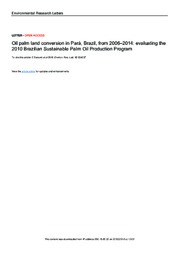Oil palm land conversion in Pará, Brazil, from 2006-2014: evaluating the 2010 Brazilian Sustainable Palm Oil Production Program.
Oil palm land conversion in Pará, Brazil, from 2006-2014: evaluating the 2010 Brazilian Sustainable Palm Oil Production Program.
Autoria: BENAMI, E.; CURRAN, L. M.; COCHRANE, M.; VENTURIERI, A.; FRANCO, R.; KNEIPP, J.; SWARTOS, A.
Resumo: Global models of biophysical suitability for oil palm consistently rank Brazil as having the greatest potential for expansion, with estimates as high as 238 Mha of suitable lands. In 2010, Brazil launched the Sustainable Palm Oil Production Program (SPOPP) to incentivize oil palm development without deforestation on as much as 30Mha. Here we examine oil palm expansion before and after the SPOPP?s launch. In Par´a, the major oil palm producing state in Brazil, we analyze the extent and change in oil palm cultivation from 2006−2014 using satellite imagery, ground-truthed verification, site-based interviews, and rural environmental (land) registration data. Between 2006−2014, oil palm area (≥9 ha) expanded >200% to ∼219 000 ha. Of the ∼148 000 ha of oil palm developed, ∼91% converted pasturelands while ∼8% replaced natural vegetation, including intact and secondary forests. Although >80% of all oil palm parcels rest <0.5 km from intact forests, direct conversion of intact forests declined from ∼4% pre-SPOPP (2006−2010) to <1% post-SPOPP (2010−2014). Despite low and declining deforestation rates associated with oil palm expansion in Par´a, our results also show a low area of oil palm development overall compared with reported land suitability. To explore potential contributing factors, we conducted semi-structured interviews with researchers, company representatives, and government officials involved in the sector to characterize the perceived factors influencing oil palm development and the role of agro-ecological suitability mapping among them. Interviews indicated that: (1) individual effects of suitability mapping efforts to encourage oil palm expansion on cleared areas, i.e. without deforestation, cannot be disentangled from pre-existing public and private deforestation reduction initiatives; and, (2) socio-economic constraints, e.g. high relative production costs and limited familiarity with this crop, appear to partially explain the major discrepancy between estimated potential suitable areas with realized oil palm development.
Ano de publicação: 2018
Tipo de publicação: Artigo de periódico
Unidade: Embrapa Amazônia Oriental
Palavras-chave: Palma de óleo, Pastagem, Sensoriamento Remoto, Sustentabilidade, Uso da Terra, Zoneamento
Observações
1 - Por padrão são exibidas publicações dos últimos 20 anos. Para encontrar publicações mais antigas, configure o filtro ano de publicação, colocando o ano a partir do qual você deseja encontrar publicações. O filtro está na coluna da esquerda na busca acima.
2 - Para ler algumas publicações da Embrapa (apenas as que estão em formato ePub), é necessário ter, no celular ou computador, um desses softwares gratuitos. Sistemas Android: Google Play Livros; IOS: iBooks; Windows e Linux: software Calibre.
Acesse outras publicações
Acesse a Base de Dados da Pesquisa Agropecuária (BDPA) para consultar o acervo completo das bibliotecas da Embrapa.

